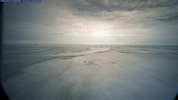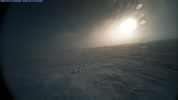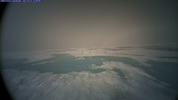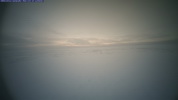About the 2012 North Pole Web Cams
 |
 |
 |
 |
|
|
Melt ponds at web cam 1 |
Polar bear tracks |
Melt ponds at web cam 2 |
last good image web cam 2 |
The 2012 North Pole web cams were deployed by the University of Washington. Images are available from the North Pole Environmental Observatory website for Web Cam 1 and Web Cam 2. See images and animations below.
On August 26, 2012, Arctic sea ice extent reached the lowest value observed so far during the satellite record. Following that low, Arctic sea ice extent continued to drop falling below 4 million square kilometers by September 5. Compared to September conditions in the 1980's and 1990's, this represents a 45% reduction in the area of the Arctic Ocean covered by sea ice. (Reference: National Snow and Ice Data Center).
2012 Web Cam animations & information:
 YouTube video of 2012 North Pole web cam #2
YouTube video of 2012 North Pole web cam #2 - Drift track data for 2012 web cam #1 and #2 from the North Pole Environmental Observatory
- Complete set of 2012 Arctic sea ice animations for web cam #1 (small or large) and #2 (small or large) as .mov files
- About the end of deployment and image transmission:
- WebCam 2 and CRREL Ice Mass Balance (IMB) Buoy 711490 last reported on 19 October 2012 from 78.251°N 000.747°W right along the ice edge
- WebCam 1 and IABP PAWS Buoy 819920 were recovered by R/V Lance along the ice edge on 7 October 2012 at 79.661°North 001.866°East
- Summer sea ice transition from 2002 - present
- a discussion of times of the onset of melt, melt pond coverage, and onset of freeze-up revealed by the North Pole Web Cams
- General Information about the North Pole Images
- more information about the web cams, what you see in the images, and the environment at the North Pole
![]()
| • Web cam Home and Acknowledgments | |
| • Daylight and Darkness at the North Pole | |
| The North Pole Web Cam is part of the North Pole Environmental Observatory, a joint National Science Foundation-sponsored effort by the Polar Science Center, / APL / UW, the Pacific Marine Environmental Laboratory / NOAA, the Japan Marine Science and Technology Center, Oregon State University, and Cold Regions Research and Engineering Laboratory. |



